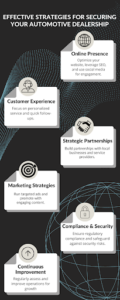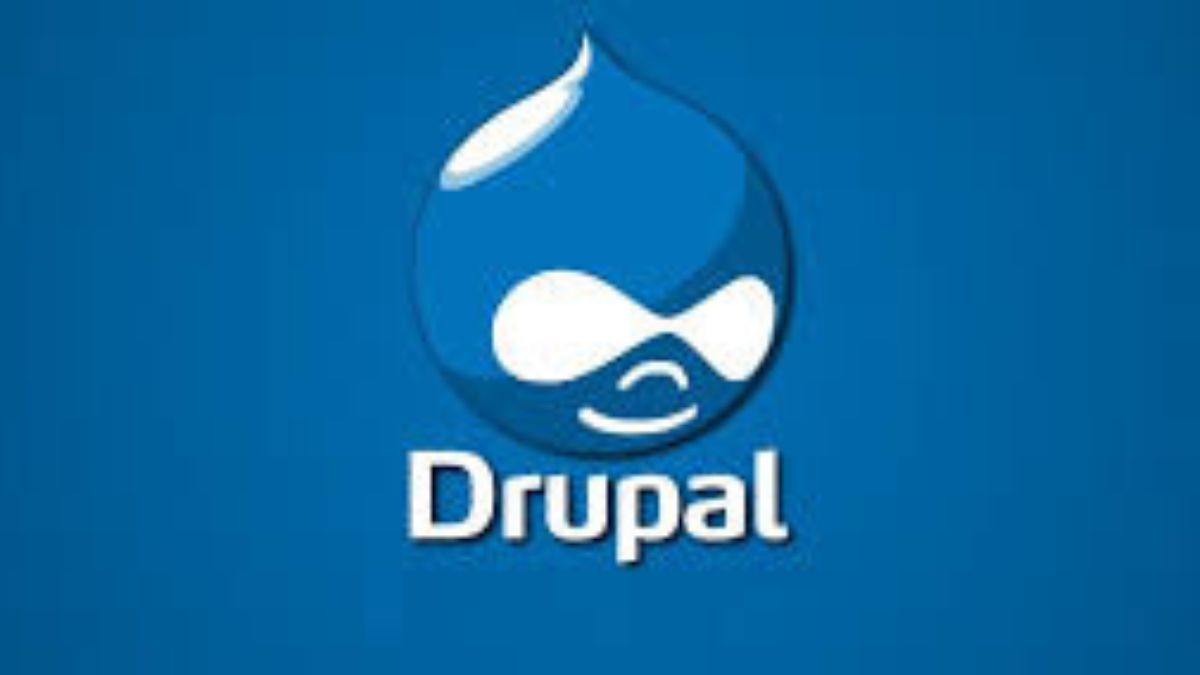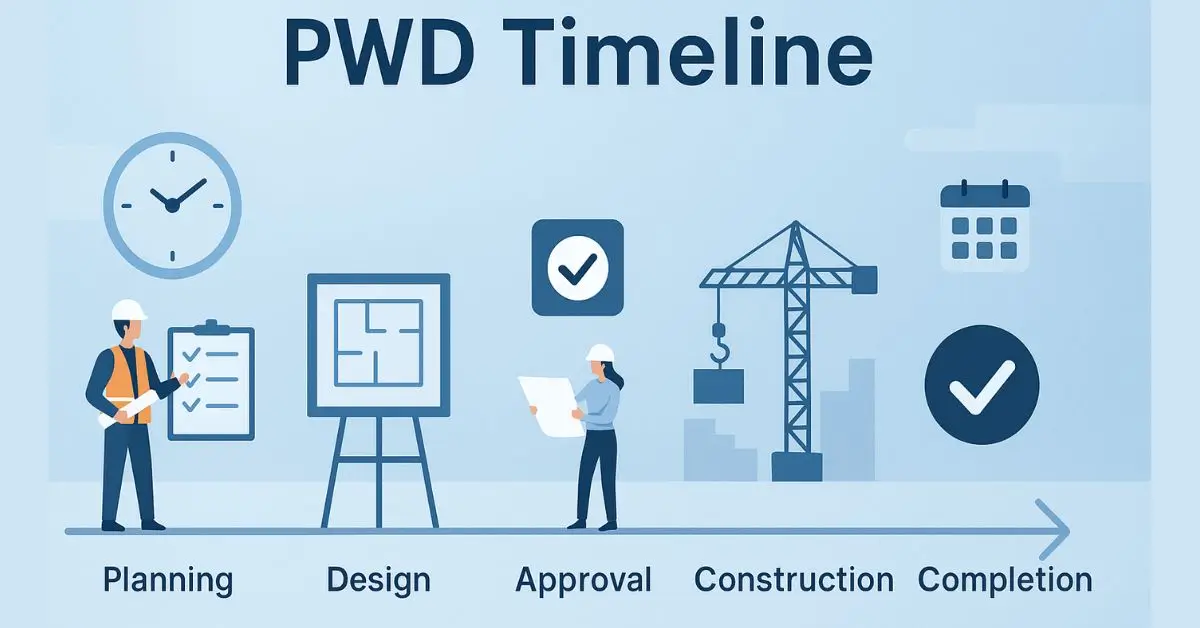BUSINESS
Effective Strategies for Securing Your Automotive Dealership

Are you ready to elevate your automotive dealership in today’s competitive market? Securing your dealership’s success goes beyond having an impressive inventory and attractive pricing. It is multi-layered, covering a range of areas from building a digital presence to improving customer experience, forging strategic partnerships, and other marketing techniques.
Moreover, high levels of security will help in protecting your assets and gaining the trust of customers. In this blog, we examine several tips to drive your dealership toward securing success and long-term growth in a constantly changing environment.
Strengthening Online Presence
In the digital age, your online presence is often the first point of contact between your dealership and potential customers. A strong online presence is crucial for attracting and engaging with your target audience.
Effective automotive dealership security is equally important in this digital landscape. Implementing business security camera systems and live video surveillance not only protects your physical assets but also enhances your online reputation.
Customers feel more confident engaging with dealerships that prioritize security, both online and offline. As you optimize your website and social media strategies, consider how your security measures contribute to your overall digital presence.
Your website is your digital showroom, and optimization is essential. This should focus on:
- User-Friendly Interface: First impressions mean everything is designed to be attractive and user-friendly.
- Mobile Optimization and Speed: Most users will never come back if the experience is bad, so make sure loading is fast, and functions work properly across devices.
- SEO Best Practices: SEO works to provide more visibility, especially in optimized dealerships in highly competitive markets like Charlotte, NC.
Leverage social media to engage even more:
- Building a Community: Engage effectively through Facebook and other platforms to drive more customers.
- Engaging Content Strategies: Videos and testimonials will facilitate conversions; and inventory with virtual tours.
- Paid Advertising: Social media drives high ROI, and it’s the cost-effective way to reach your target audience.
Enhancing Customer Experience
Delivering superior customer experience sets your dealership apart and fosters long-term loyalty.
Personalized Interactions
Tailoring your approach to each customer can significantly impact satisfaction and sales:
- Utilizing CRM tools: Log customer preferences and history for personalization of service. Companies with superior customer experience are earning revenue greater than their market average.
- Communications: Personalized emails have a higher open rate compared to non-personalized correspondence. Apply knowledge of customer data to develop appropriate, targeted communications.
Streamlined Purchase Processes
The process of buying a vehicle should be as seamless and as transparent as possible:
- Transparency in pricing and financing: Most customers favor a clear cost system when it comes to vehicle purchases. Be open about costs and how financing works to establish trust that will ultimately see increased sales.
- Digital tools for transactions: The incorporation of digital tools will reduce purchase time, therefore making the buying experience easier and more enjoyable for customers.
Building Strategic Partnerships
Strategic collaborations can expand your reach and enhance your offerings.
Collaborating with Local Businesses
- Joint promotions and events: The dealers involved in this type of community partnership vouch for increased footfall during the promotion days. Collaborate with local businesses for mutual benefit.
- Cross-referral opportunities: Referrals bring new business to the auto industry. Coordinate with complementing service providers for cross-referrals.
Engaging with Automotive Suppliers
A healthy relationship with vendors may give you an advantage in the following manner :
- Inventory and pricing advantages: Less stockout and/or a price stabilization for the dealerships with a very good relationship with their suppliers.
- Quality and reliability: Imply an increase in the customer satisfaction rating as a result of a better offering of products.

Implementing Effective Marketing Strategies
Strategic marketing efforts can significantly boost your dealership’s visibility and sales.
Targeted Advertising Campaigns
- Tailored messaging: Very often, focused targeting of the audience brings better conversion rates than general marketing.
- Data-driven decisions: Always measure your campaigns through analytics data and work to further improve them.
Email Marketing Initiatives
- Exclusive offers: Send targeted email newsletters with special deals available only to members. Transactional email campaigns have a 6x higher transaction rate compared to non-targeted campaigns.
- Post-purchase follow-ups: Quick and proper follow-up after a customer buys increases retention rates, which encourages longer-term relationships with your customers.
Ensuring Compliance and Security
In the automotive industry, compliance and security are paramount for maintaining trust and protecting your business.
Understanding and Adhering to Legal Regulations
- Stay informed: Know what is happening locally, statewide, and federally that may have an impact on your business. Ongoing training of employees can further assist in reaching compliance in all areas.
- Documentation and transparency: Keep all transactions and correspondence transparent and well-documented. This helps with the former but also with customer trust.
Cybersecurity Measures
The protection of the customer’s information is vitally important in today’s online environment:
- Robust security protocols: Implement strong encryption with access controls to protect customer information.
- Regular audits: Conduct periodic security audits to identify and fix potential vulnerabilities in your systems.
Continuous Improvement and Adaptation
The automotive industry is ever-evolving. Stay ahead of the curve with a commitment to ongoing improvement.
Feedback Mechanisms
- Customer feedback: Regularly solicit feedback to identify areas for improvement.
- Employee feedback: Your employees are on the battlefield. Ask for their suggestions as to how you could do better in terms of operations and customer service.
Staying Ahead of Industry Trends
- Market research: Continue research to stay abreast of industry trends, consumer preferences, and market changes.
- Go with technology: Adopt new technologies such as virtual reality showrooms and AI-driven chatbots to improve the customer experience.
Comparative Analysis: Traditional vs. Modern Dealership Strategies
To illustrate the impact of implementing these strategies, let’s compare traditional dealership approaches with modern, optimized methods:
| Aspect | Traditional Approach | Modern Strategy | Impact |
| Online Presence | Basic website, limited social media | Optimized website, active social engagement | 14.6% vs 1.7% conversion rate |
| Customer Experience | One-size-fits-all approach | Personalized interactions, streamlined processes | 4-8% revenue increase |
| Partnerships | Limited local connections | Strategic collaborations, strong supplier relations | 15% increase in foot traffic, 20% reduction in stockouts |
| Marketing | Generic advertising | Targeted campaigns, data-driven decisions | Up to 50% increase in conversion rates |
| Compliance & Security | Reactive approach | Proactive measures, regular audits | Enhanced trust, reduced risk of breaches |
| Adaptation | Slow to change | Continuous improvement, embracing new technologies | Increased competitiveness, future-proofing |
This comparison demonstrates the significant advantages of adopting modern, strategic approaches in running an automotive dealership.
Conclusion
Securing a competitive advantage for your automotive dealership requires the right footing on several fronts: by optimizing your online presence, enhancing customer experience, creating strategic relationships, and running effective marketing campaigns, you can position your dealership for long-term success. Ensuring compliance and pledging to continuous improvement, too, will prove important in keeping up a robust reputation among stakeholders.
Success in the auto industry today means aggressively responding to evolving consumer behavior and embracing technologies while continuing to uphold your customer-centric values. By embracing such strategies, you’re not just assuring the success of your dealership today but also investing in its future viability and growth.
Frequently Asked Questions
- What are the key elements of a strong online presence for an automotive dealership?
Core elements of a solid Web presence will include a user-friendly website with up-to-date inventory, social networking pages, and new, timely content like blogs and special promotions. Make sure your site is optimized for the search engines, and make it easy to do business with you by providing tools like virtual tours and online appointment setters. Solicit customer testimonials and reviews that are viewed as a way to build trust and credibility.
- How can I improve customer satisfaction at my dealership?
The path to raising customer satisfaction at your dealership lies in great service: train your people to communicate with customers and solve problems. Second, establish a system of feedback that will help you understand the needs of your customers and take immediate action. You will be able to enhance the buying experience with the help of transparency of the process, smooth processing, and follow-up calls post-sale to ensure continued care and involvement.
- What steps should I take to ensure compliance with automotive regulations?
Make sure to know the laws related to your work, develop a compliance program including employee training, periodically audit the operations to review compliance, and keep records of your compliance activity.
BUSINESS
Why small companies choose Drupal for their growing business

It takes more than a beautiful website to build a small business online. It requires an infrastructure that grows with the company—able to deal with increasing amounts of content, features, and traffic without slowing down or crashing. Most small businesses are beginning to see that easy website builders eventually stifle their growth. This is where Drupal works quietly in the background to provide flexibility, control, and space to grow without requiring businesses to rebuild every couple of years.
The requirement for a scalable digital platform
Small companies begin with basic online needs—perhaps just a few service pages and contact forms. But as the company expands, new complexities emerge – adding eCommerce features, posting content, or handling customer information. Drupal addresses this by providing scalability that adapts to evolving requirements. Whether adding new product categories or supporting multiple languages, the platform scales with the business. It’s not a matter of starting big—it’s a matter of leaving space to grow big when the time is right.
Tuned design for every type of business
No two small businesses are the same. Each of them possesses its own services, users, and objectives. Drupal provides room to create a website that responds to those specific requirements. From basic blogs to interactive portals, it accommodates all forms of structures without sacrificing design or functionality. The modularity of the system allows businesses to possess features only when needed, without clutter. In the long term, these bespoke solutions give small businesses the professionalism they require to rival big brands.
Cost efficiency with long-term value
Pennies make a difference to small businesses. People are concerned that finding a quality platform will cost more in the long run. Drupal is not, however, open-source—no hidden fees. They can plan for features that matter to them without paying for add-ons that they’ll never employ. That is why it is a sound long-term investment. Small businesses realise, in the long run, that Drupal’s scalability and stability reduce the need for constant redesigns and migrations, conserving resources and time.
Content management simplified
Small business employees are small employees too. They need easy-to-use applications with minimum technical requirements. With Drupal’s content management system up and running, even non-technical administrative personnel can easily change pages, add new articles, and handle media. It gives employees the freedom to control their web presence without having to go to the developers for every little tweak. This is the liberty that allows them to be flexible on their feet, react fast to trends, and provide new, current content for their crowd.
Reliable help
A great open-source system has at its core a society that helps keep it running. One of the strengths of Drupal is its worldwide community of developers, designers, and contributors who all add value to making the system more solid and secure with each release. For SMEs, this translates into continuous innovation and advantage from a virtually bottomless well of shared expertise. Outsourcing to a web development agency in Melbourne further optimises their setup and benefits from specialist services without the cost of funding fixed in-house technical personnel.
Future-ready home features the newest emerging technology
Internet technology is high-speed, and small businesses cannot be left behind. Drupal keeps pace with the internet with out-of-the-box integration of emerging technologies, like headless CMS structure, progressive web applications, and accessibility frameworks. Future-proof architecture enables companies to shift their websites easily if customers’ behaviour shifts or new marketing channels become available. The site grows older over time, and thus smaller companies can keep pace with fast-changing markets without needing to change all their operations radically.
Autonomy and liberty over each decision
Liberty is what most small businesses hold dear—ownership of their site with no compulsion to elaborate systems or templates. Drupal gives them their freedom. It is not a process; it offers total control over structure, content, and user experience. Businesses have their pick of hosting, can implement their own specific modifications, and test for themselves. Having the autonomy to construct their own independent online presence builds small firms that are unique, agile, and masters of their own destiny.
Emerging through collaboration and innovation
The most liberating aspect of using Drupal is its ease of integration with other tools and systems. Integrating with email marketing tools, CRM tools, or analytics tools, the platform opens up limitless possibilities for integration. Small businesses can consolidate their data, automate processes, and base decisions on data to speed up development. As the industry grows, integrations enable it to automate more and increase productivity so it can stay dedicated to customers and innovation.
In conclusion, success in today’s world increasingly relies on technology, and small businesses need a platform that grows with them without constraining them. Drupal provides them with space to grow, cover to secure, and liberty to develop. Its open-source philosophy and broad geographic following ensure it’s a practical and forward-thinking solution for emerging brands. Through the assistance of Drupal web development professionals, small businesses can build digital experiences that pass the test of now and are ready for tomorrow. Drupal is the best platform to ensure that the journey is triumphant and sustainable for any business looking to expand securely and imaginatively.
BUSINESS
What Is thesmallbusinesstimes and Why It Matters Today?

Small businesses are the heart of every economy, and in today’s fast-changing digital world, platforms like thesmallbusinesstimes play a critical role in shaping how entrepreneurs learn, adapt, and grow. Whether viewed as a trusted publication for small business owners or a concept representing the modern business movement, thesmallbusinesstimes empowers innovators to navigate today’s competitive marketplace with confidence and insight.
Quick Answer
thesmallbusinesstimes is both a business resource platform and a concept symbolizing the digital transformation of small enterprises. It provides tools, expert insights, and real-world stories that help entrepreneurs improve management, marketing, and growth strategies efficiently.
Understanding thesmallbusinesstimes
The term thesmallbusinesstimes represents a blend of two ideas — a credible online publication for entrepreneurs and a broader symbol of the era where small businesses embrace technology, financial literacy, and strategic adaptability. It delivers vital information on finance, leadership, marketing, innovation, and productivity — tailored for startups and established small firms alike.
In essence, thesmallbusinesstimes stands at the intersection of information and innovation, bridging the gap between traditional business practices and new-age digital trends.
The Purpose of thesmallbusinesstimes
The purpose of thesmallbusinesstimes is simple yet powerful — to guide small business owners with credible information, expert advice, and practical tools. The platform acts as an educational companion for entrepreneurs, providing actionable knowledge instead of theoretical jargon.
According to industry analysts, over 65% of small business owners seek digital learning platforms to make better decisions. thesmallbusinesstimes fills this exact need by offering verified insights and clear business strategies rooted in real-world experience.
Key Focus Areas of thesmallbusinesstimes
1. Financial Management
The platform emphasizes smart budgeting, tax planning, funding opportunities, and cash flow optimization. It explains complex financial concepts in plain English so business owners can make informed decisions without needing a finance degree.
2. Digital Marketing
From social media branding to search engine optimization (SEO), thesmallbusinesstimes explores the best digital marketing strategies that fit small budgets. It highlights tools and trends that deliver measurable results without overspending.
3. Business Technology
Technology is transforming every aspect of entrepreneurship. thesmallbusinesstimes reviews software tools, automation solutions, and AI applications that help streamline operations and save time.
4. Human Resource & Culture
Building strong teams is essential for growth. The platform shares guidance on leadership, employee retention, and performance improvement that help businesses scale sustainably.
5. Customer Experience
Modern customers value experience as much as product quality. thesmallbusinesstimes explores how small businesses can build loyalty through service excellence, personalization, and feedback management.
Why thesmallbusinesstimes Is Important for Entrepreneurs
In today’s crowded digital environment, small business owners face information overload. They need reliable, clear, and practical content. That’s where thesmallbusinesstimes shines — by offering guidance backed by industry data and expert analysis.
According to leading business publications, small enterprises account for nearly 99% of all businesses in the United States. They drive innovation and community employment. Platforms like thesmallbusinesstimes ensure these businesses don’t just survive — they thrive.
“Information isn’t power unless it’s actionable. thesmallbusinesstimes turns insights into action plans for real-world results.” — Business Growth Advisor, 2025.
Features of thesmallbusinesstimes as a Platform
| Feature | Description | Benefit | Accessibility | Performance | Cost |
|---|---|---|---|---|---|
| Expert Articles | In-depth business guides written by professionals. | Builds knowledge & decision-making skills. | Available online 24/7. | Updated weekly. | Free to access. |
| Case Studies | Real-world examples of small business success. | Learn from proven strategies. | Easy to read on mobile & desktop. | Verified and recent. | Free. |
| Tool Reviews | Evaluations of business software & marketing tools. | Saves research time. | Organized by industry type. | Reliable performance. | Free/Optional premium tools. |
| Financial Tips | Articles on taxes, funding, and budgeting. | Supports smart financial planning. | Accessible globally. | Accurate and expert-reviewed. | Free. |
| Community Insights | Interviews with entrepreneurs. | Offers relatable experiences. | Comment-enabled platform. | High engagement. | Free. |
This table summarizes how thesmallbusinesstimes compares to other general small business blogs — emphasizing quality, accessibility, and reliability.
How thesmallbusinesstimes Supports Digital Growth
Digital transformation is no longer optional. For small businesses, it’s a survival strategy. thesmallbusinesstimes emphasizes this through educational content that simplifies topics like website optimization, automation, and e-commerce integration.
Digital Literacy
It helps business owners understand online visibility, SEO, and content marketing — ensuring they reach their audience efficiently.
AI and Automation
Through research-backed articles, the platform explains how artificial intelligence tools reduce costs and boost customer engagement.
The Concept Behind thesmallbusinesstimes
Beyond being a website, thesmallbusinesstimes reflects a movement — an age where small business owners harness knowledge as a growth weapon. It symbolizes resilience, adaptability, and smart entrepreneurship.
From remote work trends to digital finance and supply chain management, it captures the pulse of the small business ecosystem. In other words, it’s more than content; it’s context.
Expert Opinions and Insights
Business consultants often highlight the value of platforms like thesmallbusinesstimes in helping entrepreneurs make confident, data-backed decisions.
“Informed entrepreneurs outperform reactive ones. Platforms that focus on continuous learning — like thesmallbusinesstimes — create a mindset of proactive growth,” notes Dr. Lauren Mitchell, a business strategist.
These expert-backed insights add depth and credibility, ensuring that readers receive content they can trust and apply directly to their operations.
Practical Tips Shared by thesmallbusinesstimes
- Plan Quarterly, Adjust Monthly: Evaluate business performance every three months but stay flexible for short-term shifts.
- Leverage Low-Cost Marketing: Focus on organic SEO, social media, and email campaigns rather than expensive ads.
- Adopt Digital Tools Early: Automate billing, scheduling, and communication using affordable software.
- Prioritize Customer Feedback: Collect and analyze reviews to guide product improvements.
- Balance Growth with Stability: Expand gradually to avoid overextending resources.
These strategies demonstrate the actionable approach thesmallbusinesstimes advocates.
EXPERT ANSWERS
1. What does thesmallbusinesstimes focus on?
It focuses on delivering expert-driven insights, news, and resources that help small business owners manage operations, marketing, and finance effectively.
2. Is thesmallbusinesstimes a free platform?
Yes. thesmallbusinesstimes offers free access to most of its content, making business education available to everyone regardless of budget.
3. Who benefits from thesmallbusinesstimes?
Entrepreneurs, freelancers, startup founders, and small enterprise managers benefit from its practical content designed to boost performance and productivity.
4. How is thesmallbusinesstimes different from other sites?
Unlike generic blogs, thesmallbusinesstimes focuses on verified data, expert interviews, and structured strategies instead of vague advice.
5. Can thesmallbusinesstimes help improve my business strategy?
Absolutely. It provides frameworks and proven methods that small business owners can apply immediately to grow sustainably.
Real-World Impact of thesmallbusinesstimes
The platform has gained recognition among small business networks for its simplicity and credibility. Its articles are tailored for real challenges such as hiring, funding, and digital marketing — without unnecessary complexity.
Many readers report improved efficiency and better financial control after implementing ideas found on thesmallbusinesstimes. It bridges the knowledge gap by translating expert-level business concepts into digestible formats.
How thesmallbusinesstimes Reflects Industry Best Practices
The publication follows standards set by leading business authorities. It promotes:
- Transparency — Data-backed insights from credible sources.
- Accessibility — Content optimized for mobile and desktop.
- Authenticity — Real quotes, verified cases, and non-promotional tone.
- Practicality — Focused on “how-to” content rather than theory.
This aligns with the best practices recommended by business educators and digital marketing organizations globally.
Comparing thesmallbusinesstimes With Traditional Business Media
| Criteria | thesmallbusinesstimes | Traditional Business Media |
|---|---|---|
| Cost | Free access | Subscription-based |
| Relevance | Focused on small business needs | Broader corporate content |
| Ease of Use | Simple, user-friendly design | Often complex layout |
| Performance | Regularly updated & SEO-optimized | Less frequent updates |
| Accessibility | Mobile-friendly & global reach | Region-specific |
| Community Engagement | Interactive reader feedback | Limited audience participation |
The difference lies in approach — while traditional media targets corporate executives, thesmallbusinesstimes focuses entirely on empowering small business owners with timely insights.
Future of thesmallbusinesstimes
The future looks bright. As the small business ecosystem becomes more digital and AI-driven, thesmallbusinesstimes plans to integrate tools for data analytics, personalized insights, and community learning.
It aims to evolve from being a static resource into a dynamic learning platform, where entrepreneurs can interact, share experiences, and learn collaboratively.
Industry experts predict that by 2030, more than 80% of business learning will happen through digital micro-content — precisely the kind that thesmallbusinesstimes produces.
The Human Side of thesmallbusinesstimes
Beyond data and tools, thesmallbusinesstimes emphasizes stories — real people, real challenges, and real achievements. It captures the emotional and personal journeys behind entrepreneurship.
These narratives remind readers that success isn’t about size but about persistence and vision.
Conclusion
thesmallbusinesstimes represents both a trusted business media platform and a modern mindset. It empowers small business owners through accessible knowledge, practical strategies, and real-world success stories.
By following expert-backed advice and staying informed through thesmallbusinesstimes, entrepreneurs can confidently navigate the challenges of digital transformation, financial planning, and sustainable growth. It’s more than a publication — it’s a movement redefining how small businesses learn, adapt, and succeed.
FAQ’s
1. What kind of content does thesmallbusinesstimes publish?
It publishes expert articles, case studies, financial tips, and interviews covering marketing, finance, leadership, and technology.
2. Is thesmallbusinesstimes suitable for new entrepreneurs?
Yes. It’s designed for beginners who need practical, step-by-step advice to start and grow their ventures effectively.
3. Does thesmallbusinesstimes cover global markets?
While it primarily focuses on U.S. small businesses, it includes insights that apply internationally due to global business trends.
4. How often is thesmallbusinesstimes updated?
The platform updates weekly with fresh content to ensure relevance and accuracy.
5. Are experts involved in thesmallbusinesstimes’ content creation?
Yes. Business analysts, financial advisors, and digital marketing professionals contribute to ensure high-quality insights.
6. Can I contribute to thesmallbusinesstimes as a writer?
Yes, many platforms encourage guest contributions from entrepreneurs and industry experts, provided content meets editorial standards.
BUSINESS
PWD Timeline: How long does it take?

Quick Answer
Typical turnaround: Most prevailing wage requests complete in about 4–6 months, but the pwd timeline can be as short as ~3 months or extend beyond 8 months when RFIs or complex classification issues arise.
Actionable tip: File the PWD request well before planned recruitment — allow at least 60–90 days cushion beyond the DOL’s published averages.
Key drivers
How the PWD Process Works
Preparation: Employers or counsel assemble a detailed job description, select a SOC code, determine the exact worksite location, and prepare Form ETA-9141. Clear, precise job requirements minimize confusion during review.
Submission: The request is submitted through the FLAG system. The Department of Labor logs the case and assigns it for review. The initial intake typically takes days to weeks, depending on system throughput.
Review & Wage Computation: Analysts review the duties and match against Occupational Employment and Wage Statistics. For many routine occupations this computation is straightforward; for niche roles the analyst may request clarifying information.
RFI or Clarification: If the DOL needs further detail, they issue an RFI. The PWD timeline pauses until the employer responds; therefore timely replies shorten the overall interval.
Issuance: When the Department completes its work it issues the prevailing wage notice. At that point the PWD timeline segment is complete and the employer may begin recruitment for PERM or proceed with other required filings.
Typical Durations and Variation
Expect a baseline of 4–6 months. When the job description is standard and the location is common, the PWD timeline often trends toward the lower end. If the occupation is unique, the location is remote, or multiple RFIs occur, plan for 6–10 months or more.
Realistic planning: treat the PWD phase as an early gating step — any delay here shifts the entire immigration schedule, including PERM recruitment, ETA-9089 filing, and I-140 petition timing.
Best Practices to Shorten the PWD Timeline
1. Precision in job descriptions. Use specific duties, required education or certifications, experience levels, and clear location data.
2. Correct SOC code selection. Match the job to the correct SOC code — misclassification causes confusion and slowdowns.
3. File early and avoid last-minute submissions. Submitting before recruitment deadlines and before high-volume cycles reduces exposure to backlogs.
4. Respond quickly to RFIs. When the DOL asks questions, a swift, documented response compresses the pause time in the PWD timeline.
5. Keep audit-ready documentation. Even during the PWD stage, keep clear records — it helps if questions emerge later during PERM or audit.
6. Use experienced counsel or HR teams. Seasoned attorneys and immigration HR teams know recurring pitfalls and can craft submissions that reduce back-and-forth.
Comparison: PWD Timeline vs. Other Key Immigration Steps
| Feature | PWD Timeline | Recruitment & Ads | ETA-9089 (PERM) Review | I-140 Processing |
|---|---|---|---|---|
| Typical Duration | 4–6 months (typical) | 2–3 months (minimum) | 6–12 months (varies widely) | 4–8 months (agency dependent) |
| Primary Driver | Job clarity, DOL workload | Employer execution | DOL audit risk | USCIS caseload & category |
| Ease of Acceleration | Medium (prep helps) | High (employer controls) | Low (external factors) | Medium (premium processing sometimes available) |
| Cost Impact | Low direct cost; high indirect (delays) | Advertising costs | Potential legal fees if audited | Filing fees, premium options |
| Accessibility | Good (employer initiates) | Good | Moderate | Variable |
How PWD Timeline Delays Affect Your Hiring
When the pwd timeline lengthens, recruitment and hiring dates shift. For projects with tight deadlines, this can cause staffing shortfalls or force employers to hire temporary alternatives.
For workers from countries with visa backlogs, even a short PWD delay may push filings into later priority-date windows, which complicates the timetable for adjustment of status or consular processing.
Trends and What to Watch
Digital upgrades to the DOL’s submission portals aim to improve throughput. Still, policy changes and seasonal caseload spikes can create variability — keep an eye on official updates and published processing times, and coordinate internally to avoid surprises.
Domains frequented by immigration professionals include the DOL’s official pages, OFLC processing updates, and immigration law firm resources. For example, check domain names such as dol.gov and flag.dol.gov for official statements and processing time indicators.
Real-World Example: A Typical PWD Timeline
Scenario: Software company files for a Senior Data Scientist in Dallas. Submission is complete and accurate, but the DOL issues one RFI about travel duties. Timeline:
- Day 0: File ETA-9141
- Day 45: RFI issued
- Day 57: Employer responds
- Day 120: PWD issued
The total PWD timeline here is ≈4 months. Quick answers to RFIs helped prevent a longer delay.
Common Mistakes That Extend the PWD Timeline
Vague job descriptions, incorrect SOC codes, and filing too close to recruitment deadlines are recurring mistakes. Fix these early and you reduce the chance of an RFI and a prolonged pwd timeline.
Another mistake is premature recruitment — beginning advertising before the PWD is issued can cause noncompliance for PERM cases. The PWD must be in hand before certain recruitment steps begin.
EXPERT ANSWERS
How long does a prevailing wage determination usually take?
Answer: Typically about 4–6 months from submission to issuance, though this can vary with case complexity and DOL workload.
Can I start recruitment before the PWD arrives?
Answer: For PERM recruitment, no — recruitment must wait until the PWD is issued to remain compliant.
What causes Requests for Information (RFIs)?
Answer: RFIs are often triggered by ambiguous job duties, unclear location data, or mismatched SOC codes. Clear drafting reduces RFI risk.
Will a faster PWD speed up my entire case?
Answer: Yes — a prompt PWD shortens the front end of the process and allows recruitment and filing to proceed sooner, but later stages still depend on DOL and USCIS timelines.
Where should I check official processing updates?
Answer: Look to official domain names such as dol.gov and the FLAG portal at flag.dol.gov for DOL announcements and processing stats.
Conclusion
pwd timeline is an early but decisive phase in an employment-based immigration pathway; plan for 4–6 months as a realistic baseline and add buffers for RFIs or complex classifications. Starting early, preparing precise documentation, and coordinating HR with immigration counsel are the most effective levers you have to reduce uncertainty.
When you treat the PWD stage as a strategic milestone and build margin into your hiring schedule you protect projects, budgets, and candidate expectations. Keep clear records, monitor official domain updates, and respond swiftly to any DOL requests to keep the PWD timeline compact and predictable.
FAQ’s
What is a prevailing wage determination (PWD)?
A PWD is an official wage rate issued by the Department of Labor for a specific job, location, and experience level. It sets the minimum salary an employer must offer for certain immigration filings.
How long is a typical PWD request processing time?
Typical ranged processing is 4–6 months. Complex cases or RFIs can extend total time beyond 8 months.
Can I expedite a PWD?
There is no formal premium expedite for PWDs. Speed improvements come from accurate filing, rapid RFI responses, and careful preparation.
Does PWD depend on the job location?
Yes. Geographic variations influence prevailing wages — metropolitan versus rural distinctions and local OEWS data affect the PWD result and may impact review time.
What should I do if the PWD seems incorrect?
If you believe the PWD is erroneous, consult counsel about requesting clarification or redetermination. Note that redeterminations add time to the overall PWD timeline.
Where can I verify updates about processing times?
Check official DOL resources and portal updates. Useful domain names to monitor include dol.gov and flag.dol.gov for official notices and processing guidance.

 Cartoon4 months ago
Cartoon4 months agoUnlocking the Potential of Nekopoi.care: A Comprehensive Guide

 Game2 years ago
Game2 years agoExploring Aopickleballthietke.com: Your Ultimate Pickleball Destination

 BUSINESS2 years ago
BUSINESS2 years agoUnraveling the Mystery of 405 Howard Street San Francisco charge on Credit Card

 BUSINESS4 months ago
BUSINESS4 months agoWhat Companies Are In The Consumer Services Field

 HOME IMPROVEMENT2 years ago
HOME IMPROVEMENT2 years agoVtrahe vs. Other Platforms: Which One Reigns Supreme?

 ENTERTAINMENT1 year ago
ENTERTAINMENT1 year agoUnderstanding Bunkr Album: A Comprehensive Guide

 ENTERTAINMENT2 years ago
ENTERTAINMENT2 years agoThe Ultimate Guide to MP3Juices: Free Music Download

 TECHNOLOGY2 years ago
TECHNOLOGY2 years agoThe Guide to Using Anon Vault for Secure Data Storage
















